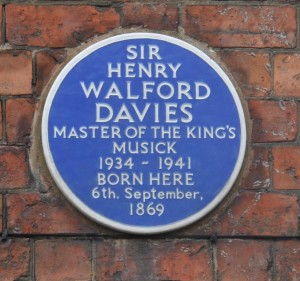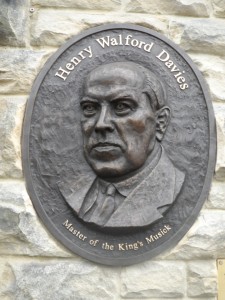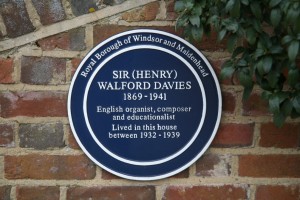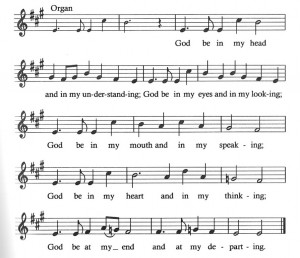 Willow Street to Windsor
Willow Street to Windsor
Born at Willow Street, Oswestry in 1869 Henry Walford Davies was one of nine children in a nonconformist family which attended the Congregational Chapel known as Christ Church. The young Henry was surrounded by musical ability. His father played flute and cello, his uncle was church organist. In the fullness of time Henry’s brothers Charlie and Harold became church organist. The instrument they played is still in the church as is the choir recess in which the young Henry, together with others, sang.
Henry’s musical activity was not limited to singing. Like others in the family he learned to play several instruments including the organ. Together they took part in informal and formal concerts, entertainments they enjoyed giving and which were well received.
While the children thrived and grew some of their talents augured distinguished futures. Harold emigrated to Australia and there he gained the first musical doctorate at an Australian University. His reputation grew and he became Professor of Music at Adelaide University.
 Henry had general musical ability but in his early years his prime talent was singing. When he was twelve years old he gained a choristership at St. George’s Chapel, Windsor. The Windsor environment was demanding. There were fourteen services every week. There was choir practice. There was school. And there was Walter Parrat a leader in the late Victorian organ renaissance. Maturing through his teens Henry studied under Walter Parrat for five years and became his assistant organist. The Dean at that time was Randall Davidson. Henry became the Dean’s Secretary in 1885, an appointment which shows the esteem in which Henry was held. Randall Davidson subsequently became Archbishop of Canterbury and in that capacity influenced part of Henry’s future. Although it may seldom have seemed so the Windsor environment had many similarities with home. Talent was to be stretched, standards were to be achieved and both would be done in an atmosphere of faith and belief.
Henry had general musical ability but in his early years his prime talent was singing. When he was twelve years old he gained a choristership at St. George’s Chapel, Windsor. The Windsor environment was demanding. There were fourteen services every week. There was choir practice. There was school. And there was Walter Parrat a leader in the late Victorian organ renaissance. Maturing through his teens Henry studied under Walter Parrat for five years and became his assistant organist. The Dean at that time was Randall Davidson. Henry became the Dean’s Secretary in 1885, an appointment which shows the esteem in which Henry was held. Randall Davidson subsequently became Archbishop of Canterbury and in that capacity influenced part of Henry’s future. Although it may seldom have seemed so the Windsor environment had many similarities with home. Talent was to be stretched, standards were to be achieved and both would be done in an atmosphere of faith and belief.
Teacher and Organist
In 1890 Davies gained an open scholarship in composition at the Royal College of Music. There he studied under Hubert Parry and Charles Villiers Stanford and continued at the college as a teacher of counterpoint, a post he held from 1895 until 1918. During the same period he was organist at several London churches. In sequence they were St. John’s Soho (1890 – 1891), Christ Church Hampstead (1891 – 1898), and the Temple Church (1898 – 1917). He had also become conductor of the Bach Choir a post he held for five years. This period shows Davies’ continuing academic stature combined with public performance as a musician of stature in a context of faith. But other strands were emerging that placed Davies on an even broader stage.
Wartime and afterwards
Between 1915 and 1917 Davies made several visits to France giving concerts for servicemen. Upon the creation of the RAF he was appointed its Director of Music with the rank of Major, composing the well known RAF March Past. Later compositions for military and brass bands included the Red Cross March and the March of the Fire Brigades.
Henry became Gregynog Professor of Music at Aberystwyth University in 1919, a post which gave wider opportunity for his broad musical talents. He was at the same time Musical Director of the University of Wales. Later he became chairman of the National Council of Music for Wales and helped greatly with the promotion of Welsh music.
Work for the BBC
Other avenues beckoned. In the 1920s Davies made a series of recorded lectures, mainly on melody which appeared under the HMV label. It was at this time that John Reith was leading and forming an emergent British Broadcasting Corporation. In 1923 Reith was Managing Director and from 1927 he was Director General. Davies’ recordings enjoyed considerable success. BBC interest arose. Henry made his first broadcast in 1924 and by 1939 he had given over 400 broadcasts aimed at the average listener with a view to making more clear their understanding and appreciation of classical music. The relatively young Reith aspiring to create a public service that educated, informed and entertained must have found in the mature Davies an ideal person to help fulfil those aspirations.
Turbulent Times
There were other posts and work. In 1924 Davies was appointed Professor of Music at Gresham College, London. Nominally a part time post Henry held the position while continuing all of his other duties in Wales. By this time Davies was recognised as a distinguished composer and performer of church music.
When in 1924 Sir Walter Parrat, who had tutored Davies in organ some thirty four years earlier, died, Henry Walford Davies was immediately offered the post of Organist and Choirmaster at St. George’s Chapel by the Dean and Canons of Windsor. Davies dearly wished to take up the offer and the Chapter was clearly keen that he should. However, Davies had a range of commitments he had made which he felt obliged to fulfil. It appeared that both Davies and Chapter would be disappointed but an arrangement was made for a temporary appointment. This kept the door open for Davies to accept at a future date. In the event, following an illness which led to him relinquishing his chair at Aberystwyth, Davies took up the appointment of Organist and Choirmaster in 1927. It is widely thought that Randal Davidson, who by then had become Archbishop of Canterbury, exerted his influence to keep the door open for his former Secretary.
An Imperfect Match
It was not foreseen that Davies’ hopes, those of the Chapter and some of his colleagues would become imperfectly matched. Most Anglicans were steeped in a traditional liturgy with a near majestic habit of choral worship. Davies was able to fully partake in that tradition but was an enthusiast for new musical opportunity. Such an opportunity occurred when a replacement organ was considered. Davies argued strongly for a double console organ. Allowing two organists it would in Davies view give great possibilities in performance and tuition. Most of the Chapter appear to have been very reluctant, not least on grounds of cost. Provision of a second console would cost a further £1,000. Davies offered to meet the additional cost, the double console was commissioned and the Chapter later refunded the £1000.
Walford had composed a new Te Deum which was performed when the new organ was inaugurated in late 1930. That was a great success but Davies’ choice of music for worship met adverse criticism. His approach conflicted with more traditional views. Davies resigned as Organist in November 1932. The Chapter minute reads
“while regretting the resignation of Sir Walter Davies they do not question the wisdom of his decision and accordingly accept it with a deep sense of gratitude for his services to St. George’s throughout an important period in its history.”
Remembrance in Windsor
Presumably the Davies family removed here following his resignation as Organist and Choirmaster. While he had resigned a much sought position he was not short of work or public recognition.
In 1932 he was appointed Commander of the Victorian Order. In 1935 he received an honorary Doctorate in Music from Oxford University.
1934 saw him appointed as Master of the King’s Musick in succession to Sir Edward Elgar. Analogous to the position of Poet Laureate the Master was expected to compose music for important royal occasions.
He composed an elegy in memory of King George V and composed coronation music celebrating the accession of King George the VI in 1937. In the same year he became a Knight Commander of the Victorian Order. In April 1937 his fantasy entitled “Big Ben Looks On” was performed at the Central Hall, Westminster as part of King George VI coronation celebrations. It was dedicated to the young Princesses Elizabeth and Margaret Rose who, with their mother Queen Elizabeth, attended the concert.
It was in this period that Davies became a Freeman of Oswestry.
Remembrance in Oswestry
 Sir Henry Walford Davies is now commemorated in Oswestry in a fine bas relief sculpted by Heather Burley. It shows Davies as a mature man and is influenced by photographs taken by Bossano in 1929 that are now lodged in the National Portrait Gallery. Also in Oswestry and in Christ Church is a hymnal, Rejoice and Sing. Number 498 carries the sixteenth century words to a tune composed by Davies. It reminds us of Davies the organist, Davies the composer, Davies the musician and Davies the man of faith. The young Henry could not have credited the prospect of such achievements.
Sir Henry Walford Davies is now commemorated in Oswestry in a fine bas relief sculpted by Heather Burley. It shows Davies as a mature man and is influenced by photographs taken by Bossano in 1929 that are now lodged in the National Portrait Gallery. Also in Oswestry and in Christ Church is a hymnal, Rejoice and Sing. Number 498 carries the sixteenth century words to a tune composed by Davies. It reminds us of Davies the organist, Davies the composer, Davies the musician and Davies the man of faith. The young Henry could not have credited the prospect of such achievements.
You might like to read
Walford Davies – A Biography H C Colles Oxford University Press 1942
Sir Henry Walford Davies – An Affectionate Tribute Christopher Symons Oswestry Civic Society
©Charles Stiles 2013
This article is copyrighted, please contact the group before using any information or pictures, held in this article.


